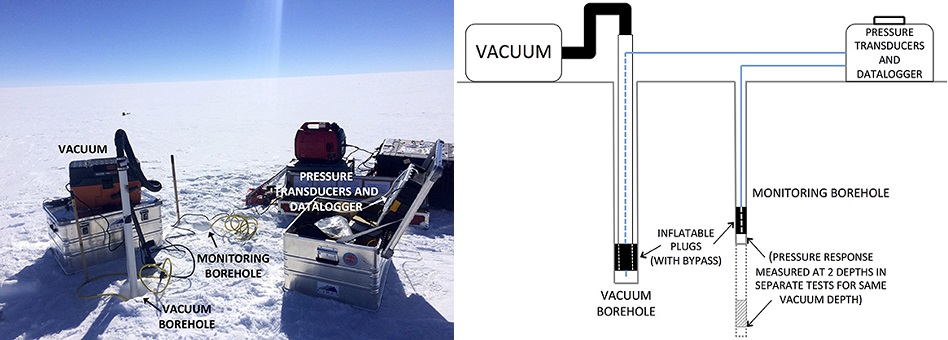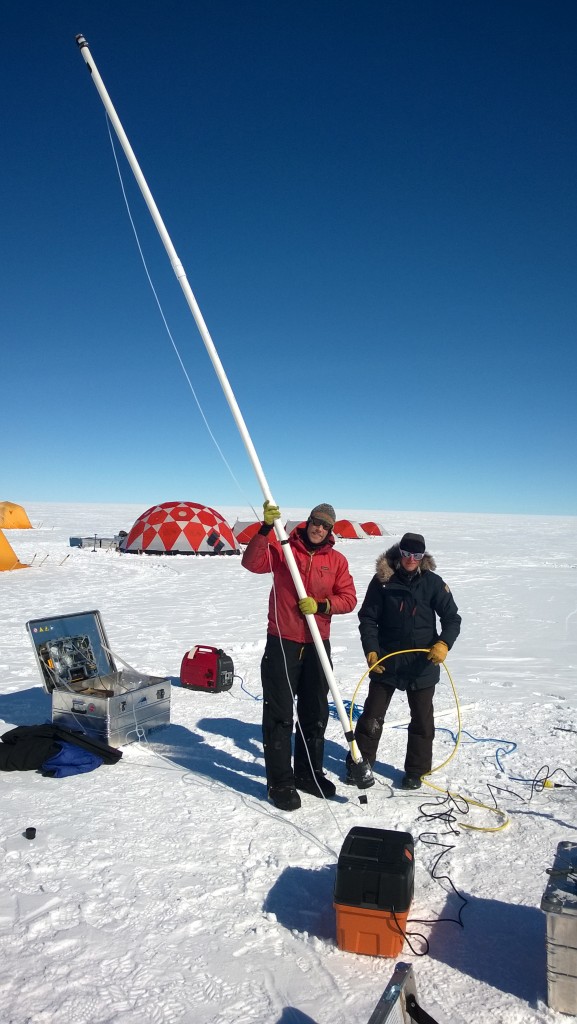We have an open-access study that explores the various ways by which meltwater drains from the Greenland ice sheet in the current volume of Journal of Glaciology1. While surface meltwater rivers and lakes are a conspicuous feature of the Greenland ice sheet, virtually all meltwater that drains from the ice-sheet margin is flowing either within or beneath the ice sheet, rather than on its surface. Where and how meltwater reaches the ice-sheet bed can have implications on ice dynamics. For example, the sharp pulses of meltwater transmitted to the bed by near-vertical conduits called moulins are believed to cause more sliding at the ice-bed interface than the subdued pulses transmitted by crevasses.
In the study, we simulated a portion of the ice sheet in West Greenland known as Paakitsoq, using a computer model. The model used the measured ice sheet topography, as well as observed locations of crevasses and moulins, to simulate how meltwater was produced and flowed across the ice sheet surface under the climate conditions of the 2009 average intensity melt season and the 2012 extreme intensity melt season. The model could also simulate catastrophic lake drainage events, known as hydrofracture events, when a surface lake becomes sufficiently deep that its pressure fractures the underlying ice and creates a new moulin.

Figure 1 – Location of the Paakitsoq study area. Black outline denotes the model domain. Blue dots denote moulin locations identified in satellite imagery. Black contours denote surface elevations. Base image is Landsat-8 from 4 August 2014.
Our simulations suggested that, during an average intensity melt season, crevasses drain almost half (47 %) of ice-sheet meltwater. The hydrofracture of surface lakes drained about 24 % of ice-sheet meltwater, the majority of which resulted from drainage into new moulins following hydrofracture events, rather than the hydrofracture events themselves. Previously existing moulins drained an additional 15 % of meltwater. (The remaining meltwater either reached the ice-sheet margin, remained stored within the model area, or drained to ice-sheet areas North or South of the model area.)
While our simulations suggest that crevasses now drain more meltwater from the ice sheet at Paakitsoq (47 %) than previously existing and newly hydrofractured moulins together (39 %), our 2012 extreme intensity melt season simulation suggests that this ratio may change. The proportion of meltwater drainage via moulins increases, and the proportion of drainage via crevasses decreases, in the 2012 extreme intensity melt season simulation, which may be characteristic of a warmer future climate. This increase in both relative and absolute moulin drainage under warmer conditions is due to an increase in moulins created by hydrofracture events, as meltwater production moves to higher elevations.

Figure 2 – Partitioning surface meltwater drainage into eight categories under the average melt (2009; R1) and extreme melt (2012; R11) simulations. “Lake” is the volume remaining in lakes at season end. “Remaining Flow” is the volume in transit at season end. “Lateral Outflow” is the volume that drains through North and South model domain boundaries. “Ice Margin” is the volume that reaches the ice-sheet edge. The volumes captured in “Crevasses” and “Moulins” are denoted. The volumes drained by lake hydrofracture induced surface-to-bed connections are “Lake Hydrofracture Lake” (LHL), while the subsequent drainage into the new surface-to-bed connection is “Lake Hydrofracture Moulin” (LHM).
Overall, our study provided insight on the space-time variation of pathways by which the vast majority of ice-sheet meltwater descends to the ice-sheet bed prior to reaching the ice-sheet margin. A better understanding of how meltwater travels through the ice-sheet can help improve scientific understanding of not only the ice-sheet mass loss caused by runoff, but also the implications of increasing meltwater production on the mass loss caused ice dynamics. Our simulations also suggest there is value in ice-sheet wide mapping of surface hydrology features like crevasses, rivers, lakes, and moulins, as computer models can use this knowledge to improve simulations of meltwater routing.
Intro to our #openaccess study partitioning ice-sheet runoff via crevasses & moulins under differing melt intensity: https://t.co/eXWnY4jzCI pic.twitter.com/fgTffICmfy
— William Colgan (@GlacierBytes) March 22, 2017



